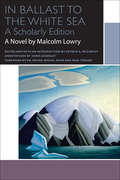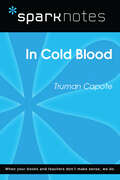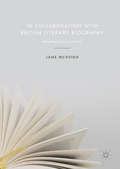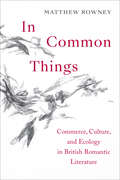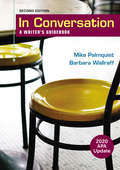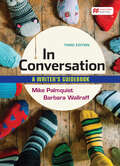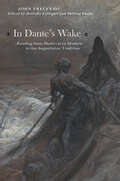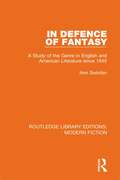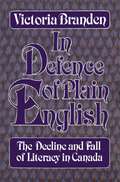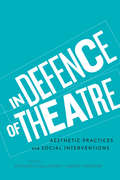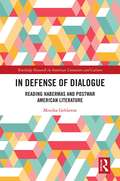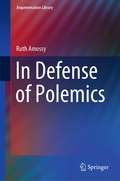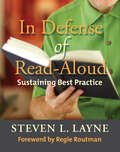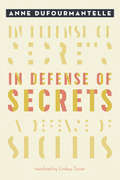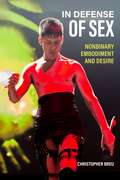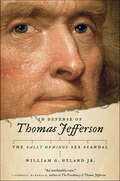- Table View
- List View
In A Pickle: Other Funny Idioms
by Marvin TerbanThirty common English phrases, such as "a chip off the old block" and "cry over spilled milk" are explained.
In Another Country: Colonialism, Culture, and the English Novel in India
by Priya JoshiAsking what Indian readers chose to read and why, In Another Country shows how readers of the English novel transformed the literary and cultural influences of empire. She further demonstrates how Indian novelists writing in English, from Krupa Satthianadhan to Salman Rushdie, took an alien form in an alien language and used it to address local needs. Taken together in this manner, reading and writing reveal the complex ways in which culture is continually translated and transformed in a colonial and postcolonial context.
In Another Country: Colonialism, Culture, and the English Novel in India
by Priya JoshiIn a work of stunning archival recovery and interpretive virtuosity, Priya Joshi illuminates the cultural work performed by two kinds of English novels in India during the colonial and postcolonial periods. Spanning the nineteenth and twentieth centuries, readers and writers, empire and nation, consumption and production, In Another Country vividly explores a process by which first readers and then writers of the English novel indigenized the once imperial form and put it to their own uses. Asking what nineteenth-century Indian readers chose to read and why, Joshi shows how these readers transformed the literary and cultural influences of empire. By subsequently analyzing the eventual rise of the English novel in India, she further demonstrates how Indian novelists, from Krupa Satthianadhan to Salman Rushdie, took an alien form in an alien language and used it to address local needs. Taken together in this manner, reading and writing reveal the complex ways in which culture is continually translated and transformed in a colonial and postcolonial context.
In Ballast to the White Sea (Canadian Literature Collection)
by Malcolm LowryIn Ballast to the White Sea is Malcolm Lowry’s most ambitious work of the mid-1930s. Inspired by his life experience, the novel recounts the story of a Cambridge undergraduate who aspires to be a writer but has come to believe that both his book and, in a sense, his life have already been “written.” After a fire broke out in Lowry’s squatter’s shack, all that remained of In Ballast to the White Sea were a few sheets of paper. Only decades after Lowry’s death did it become known that his first wife, Jan Gabrial, still had a typescript. This scholarly edition presents, for the first time, the once-lost novel. Patrick McCarthy’s critical introduction offers insight into Lowry’s sense of himself while Chris Ackerley’s extensive annotations provide important information about Lowry’s life and art in an edition that will captivate readers and scholars alike.
In Between Communication Theories Through One Hundred Questions (Numanities - Arts and Humanities in Progress #14)
by Tomas Kačerauskas Algis MickūnasThis book takes the form of a dialogue. It presents two authors, specialized in the phenomenologу, posing questions to each other and offering complex answers for critical discussion. The book includes both presentation of different communication schools and philosophizing on the issues of communication. The authors debate numerous topics by providing the definition and etymology of communication, examining the limits of communication, and using a poli-logical base of communication. The issue which pervades all domains is that of mediation: how things, such as identities, styles, and bodies are mediated by culture, history, and tradition, and what the limits are of such mediation. This question leads to more complex issues of “mediated mediations” such that an explication of one medium is framed by another medium, leading to a question of meta-language as a fundamental, unmediated medium. This involves some fine points of mediation: perspectivity, discursivity, ethics of communication, ideology, private and public. Throughout the mutual, interrogative dialogue, the authors touch upon, but avoid the daunting commitment to, a theory of metacommunication, as well as the “transcendental” problematic of accessing the numerous theoretical, thematic, and historical aspects of communication.
In Cold Blood (SparkNotes Literature Guide Series)
by SparkNotesIn Cold Blood (SparkNotes Literature Guide) by Truman Capote Making the reading experience fun! Created by Harvard students for students everywhere, SparkNotes is a new breed of study guide: smarter, better, faster. Geared to what today's students need to know, SparkNotes provides: *Chapter-by-chapter analysis *Explanations of key themes, motifs, and symbols *A review quiz and essay topicsLively and accessible, these guides are perfect for late-night studying and writing papers
In Collaboration with British Literary Biography: Haunting Conversations
by Jane McveighThis book is about one person’s reading and what has been learnt about how the lives of other people, particularly authors, have been written in British literary biographies over the last fifty years. It is less interested in what happened in the lives of the people described in these biographies, and more concerned with how these stories have been told. It aims to have a conversation with British biographers, particularly Michael Holroyd, Richard Holmes, Hermione Lee and Claire Tomalin, to make their voices heard, to set them talking. It understands biography as an ongoing collaboration, not only between biographers and their subjects, but between biographers and their readers. This is also a study of haunting, in which we haunt the lives of others to help us come to a better understanding of our own.
In Common Things: Commerce, Culture, and Ecology in British Romantic Literature
by Matthew RowneyThe hardness of stone, the pliancy of wood, the fluidity of palm oil, the crystalline nature of salt, and the vegetable qualities of moss – each describes a way of being in and understanding the world. These substances are both natural objects hailed in Romantic literature and global commodities within a system of extraction and exchange that has driven climate change, representing the paradox of the modern relation to materiality. In Common Things examines these five common substances – stone, wood, oil, salt, and moss – in the literature of Romantic period authors, excavating their cultural, ecological, and commodity histories. The book argues that the substances and their histories have shaped cultural consciousness, and that Romantic era texts formally encode this shaping. Matthew Rowney draws together processes, beings, and things, both from the Romantic period and from our current ecological moment, to re-invoke a lost heritage of cultural relations with common substances. Enabling a fresh reading of Romantic literature, In Common Things prompts a reevaluation of the simple, the everyday, and the common, in light of their contributions to our contemporary sense of ourselves and our societies.
In Conversation with Exercises: A Writer's Guidebook
by Mike Palmquist Barbara WallraffIn Conversation with Exercises helps you think critically about why you’re writing and who you’re writing to while preparing you for all the kinds of writing you need to do.
In Conversation: A Writer's Guidebook
by Mike Palmquist Barbara Wallraff2020 APA Update. With a strong rhetorical foundation, In Conversation blends the comprehensive coverage and quick navigation of a pocket-size handbook with the guidance of a rhetoric. Students will see themselves in its vibrant visuals and real-world examples. The second edition of this approachable and affordable guidebook provides even more help for the kinds of writing students do in college, with new robust support for multilingual writers, new coverage of analytical writing, and a new appendix of sentence guides for academic writing.
In Conversation: A Writer's Guidebook
by Mike Palmquist Barbara WallraffIn Conversation helps you think critically about why you’re writing and who you’re writing to while preparing you for all the kinds of writing you need to do.
In Conversation: A Writer's Guidebook with Exercises
by Mike Palmquist Barbara WallraffWith 2020 APA Update. With a strong rhetorical foundation, In Conversation blends the comprehensive coverage and quick navigation of a pocket-size handbook with the guidance of a rhetoric. Students will see themselves in its vibrant visuals and real-world examples. The second edition of this approachable and affordable guidebook provides even more help for the kinds of writing students do in college, with new robust support for multilingual writers, new coverage of analytical writing, practice exercises, and a new appendix of sentence guides for academic writing.
In Dante's Wake: Reading from Medieval to Modern in the Augustinian Tradition
by John FrecceroWaking to find himself shipwrecked on a strange shore before a dark wood, the pilgrim of the Divine Comedy realizes he must set his sights higher and guide his ship to a radically different port. Starting on the sand of that very shore with Dante, John Freccero begins retracing the famous voyage recounted by the poet nearly 700 years ago.Freccero follows pilgrim and poet through the Comedy and then beyond, inviting readers both uninitiated and accomplished to join him in navigating this complex medieval masterpiece and its influence on later literature. Perfectly impenetrable in its poetry and unabashedly ambitious in its content, the Divine Comedy is the cosmos collapsed on itself, heavy with dense matter and impossible to expand. Yet Dante’s great triumph is seen in the tiny, subtle fragments that make up the seamless whole, pieces that the poet painstakingly sewed together to form a work that insinuates itself into the reader and inspires the work of the next author. Freccero magnifies the most infinitesimal elements of that intricate construction to identify self-similar parts, revealing the full breadth of the great poem.Using this same technique, Freccero then turns to later giants of literature— Petrarch, Machiavelli, Donne, Joyce, and Svevo—demonstrating how these authors absorbed these smallest parts and reproduced Dante in their own work. In the process, he confronts questions of faith, friendship, gender, politics, poetry, and sexuality, so that traveling with Freccero, the reader will both cross unknown territory and reimagine familiar faces, swimming always in Dante’s wake.
In Defence of Fantasy: A Study of the Genre in English and American Literature since 1945 (Routledge Library Editions: Modern Fiction)
by Ann SwinfenThe modern fantasy novel might hardly seem to need a defence, but its position in contemporary literature in the 1980s was still rather ambivalent. Many post-war writers had produced highly successful fantasy novels, some phenomenal publishing successes had occurred in the field, and an increasing number of universities throughout the English-speaking world now included the literary criticism of fantasy as part of their English Literature courses. None the less some critics and academics condemned the whole genre with a passion that seemed less than objectively critical. In this book, originally published in 1984, Dr Ann Swinfen presents a wide-ranging and comprehensive view of fantasy: what it is, what it tries to achieve, what fundamental differences distinguish it from mainstream realist fiction. She concentrates on the three decades from 1945, when a new generation of writers found that Tolkein had made fantasy ‘respectable’. Her approach is thematic, rather than by individual author, and she brings out the profound moral purpose that underlies much modern fantasy, in a wide range of works, both British and American, such as Russell Hoban’s The Mouse and His Child, C.S. Lewis’s Chronicles of Narnia and Ursula Le Guin’s Earthsea Trilogy.
In Defence of History
by Richard J. Evans&“A lucid, muscular, and often sly reflection&” on the worth and purpose of historical scholarship by the award-winning author of The Third Reich Trilogy (Kirkus).In this volume, the renowned historian Richard J. Evans offers a fervent and deeply insightful defense of his craft and its importance to civilization. At a time when fact and historical truth are under unprecedented assault, Evans shows us why history is necessary. Taking us into the historians&’ workshop, he offers a firsthand look at how good history gets written. In staunch opposition to the wilder claims of postmodern historians, Evans thoroughly dismantles the notion that a realistic grasp of history is impossible to attain. He then goes on to explain the deadly political dangers of losing a historical perspective on the way we live our lives. In the tradition of E.H. Carr&’s What Is History? and G.R. Elton&’s The Practice of History, Evans&’ In Defense of History delivers &“a model of lucid and intelligent historiographical analysis&” (The Guardian, UK).
In Defence of Plain English: The Decline and Fall of Literacy in Canada
by Victoria BrandenThis indispensable guide to the English language belongs beside the dictionary in every Canadian home. Written in an easy-to-understand light-hearted style, the content of the book is nevertheless serious and important. Our language is declining; illiteracy is rampant. Worse, the sloppy, incorrect use of language is perpetrated by educators, the media, politicians, and others who should be setting a good example.Besides giving simple illustrations of the correct use of grammar and choice of words, the author deals with the commonest offences: language misused, mis-spelled, and misunderstood, and the appalling use of words (usually incorrect) that many people consider sophisticated or "classy."Using actual quotations from essays of university students, the media, and even "good" books, the author clearly defines bad English and explains in a straightforward manner how to change it to good English. What makes this book unique is its complete lack of pretentiousness and its powerful plea for the return of plain English.
In Defence of Theatre: Aesthetic Practices and Social Interventions
by Kathleen Gallagher Barry FreemanWhy theatre now? Reflecting on the mix of challenges and opportunities that face theatre in communities that are necessarily becoming global in scope and technologically driven, In Defence of Theatre offers a range of passionate reflections on this important question.Kathleen Gallagher and Barry Freeman bring together nineteen playwrights, actors, directors, scholars, and educators who discuss the role that theatre can - and must - play in professional, community, and educational venues. Stepping back from their daily work, they offer scholarly research, artists' reflections, interviews, and creative texts that argue for theatre as a response to the political and cultural challenges emerging in the twenty-first century. Contributors address theatre's contribution to local and global politics of place, its power as an antidote to various modern social ailments, and its pursuit of equality. Of equal concern are the systematic and practical challenges that confront those involved in realizing theatre's full potential.
In Defense of Dialogue: Reading Habermas and Postwar American Literature (Routledge Research in American Literature and Culture)
by Monika GehlawatIn Defense of Dialogue: Reading Habermas and Postwar American Literature offers a timely investigation of the value of dialogue in contemporary American culture. Using Jürgen Habermas’s theory of communicative action to read the work of Frank O’Hara, James Baldwin, Grace Paley, and Andy Warhol, In Defense of Dialogue assembles postwar writers who have never been studied alongside one another, showing how they overcame the pervading skepticism of their contemporaries to imagine sincere and rational speakers who seek to cultivate intersubjective discourse.
In Defense of Nothing: Selected Poems, 1987–2011 (Wesleyan Poetry Series)
by Peter GizziA new lyricism for the twenty-first centuryRunner-up for the William Carlos Williams Award (2015) Since his celebrated first book of poetry, Peter Gizzi has been hailed as one of the most significant and distinctive voices writing today. Gathered from over five collections, and representing close to twenty-five years of work, the poems in this generous selection strike a dynamic balance of honesty, emotion, intellectual depth and otherworldly resonance—in Gizzi's work, poetry itself becomes a primary ground of human experience. Haunted, vibrant, and saturated with luminous detail, Gizzi's poetry enlists the American vernacular in a magical and complex music. In Defense of Nothing is an immensely valuable introduction to the work of this extraordinary and singular poet. Check for the online reader's companion at http://petergizzi.site.weleyan.edu.
In Defense of Polemics (Argumentation Library #42)
by Ruth AmossyThis book revisits the definition of polemical discourse and deals with its functions in the democratic sphere. It first examines theoretical questions concerning the management of disagreement in democracy and the nature of polemical discourse. Next, it analyses case studies involving such issues as the place of women in the public space, illustrated by the case of the burqa in France and public controversy in the media on the exclusion of women from the public space. The book then explores reason, passion and violence in polemical discourse by means of cases involving confrontations between secular and ultra-orthodox circles, controversies about the Mexican Wall and fierce discussions about stock-options, and bonuses in times of financial crisis.Although polemical exchanges in the public sphere exacerbate dissent instead of resolving conflicts, they are quite frequent in the media and on the Net. How can we explain such a paradox? Most studies in argumentation avoid the question: they mainly focus on the verbal procedures leading to agreement. This focus stems from the centrality conferred upon consensus in our democratic societies, where decisions should be the result of a process of deliberation. What is then the social function of a confrontational management of dissent that does not primarily seek to achieve agreement? Is it just a sign of decadence, failure and powerlessness, or does it play a constructive role? This book answers these questions.
In Defense of Read-Aloud: Sustaining Best Practice
by Steven LayneAs accountability measures for schools and teachers continue to grow, instructional practice is under the microscope. The practice of reading aloud to children may be viewed by some educators as an extra bit of fluff used solely for the purposes of enjoyment or filling a few spare minutes,but researchers and practitioners stand in solidarity: the practice of reading aloud throughout the grades is not only viable but also best practice.In Defense of Read-Aloud: Sustaining Best Practices, author Steven Layne reinforces readers' confidence to continue the practice of reading aloud and presents the research base to defend the practice in grades K12. Layne also offers significant practical insights to strengthen instructional practice-;answering the questions of Why should we?- and How should we? and provides practical advice about how to use read-alouds most effectively.Leading researchers in the field of literacy provide position statements, authors of professional books share insights on books they have loved, leaders of the largest literacy organizations in the United States write about their favorite read-alouds, award-winning authors of children's and young adult book (Katherine Paterson, Andrew Clements, Lois Lowry, to name a few) share the powerful behind-the-scenes stories of their greatest books, and real classroom teachers and librarians speak about books that have lit up- their classrooms and libraries around the world.Last but not least,In Defense of Read-Aloud features many great recommendations of books to share with children.Read-aloud is an essential practice in teaching literacy in grades K -12. In this book, Steven Layne has provided everything needed to support, sustain, and celebrate the power of read-aloud.
In Defense of Secrets
by Anne DufourmantelleIn an age that prizes political and personal transparency, In Defense of the Secret champions the secret as what permits relation and ensures our humanity.Psychoanalyst and philosopher Anne Dufourmantelle drowned in 2017 in an attempt to rescue two children caught in the ocean. Her work lives on, though, in this provocative and necessary book. Through etymologies and case studies, personal history and incisive commentary on contemporary society, In Defense of Secrets returns us to the fundamental psychic scene of the secret. The secret, for Dufourmantelle, is not a code to be cracked or a firewall to be penetrated but a dynamic and powerful entity that permits relation and that ensures our humanity.Tracking the secret though art and literature, philosophy, psychoanalysis, and sociology, from the Inquisition to the present, Dufourmantelle’s writing spirals around the question of the secret’s value. In our age, when political and personal transparency seem to be prized above all—lives posted on the Internet, information leaked, whistles blown, taboos absent except with respect to the secret itself—In Defense of Secrets champions what remains hidden, private, veiled, hushed, just out of sight. The secret is on the side of nature, not science; organic growth, not technology; love’s generosity, not knowledge’s grasp. For Dufourmantelle, the secret is a powerful and dynamic thing: deadly if unheard or misused, perhaps, but equally the source of creativity and of ethics. An ethics of the secret, we can hear her say, means listening hard and sensitively, respecting the secret in its secret essence, unafraid of it and open to what it has to say.
In Defense of Sex: Nonbinary Embodiment and Desire
by Christopher BreuExamines the need to recenter the category of sex–theorizing sex itself as nonbinary–in contemporary studies of gender and sexualityGender has largely replaced sex as a category in critical theory, in progressive cultural circles, and in everyday bureaucratic language. Much of this development has been salutary. Gender has become a crucial site for theorizing trans identifications and embodiments. Yet, without a concomitant theory of sex, gender’s contemporary uses also intersect with late neoliberalism’s emphasis on micro-identities, flexibility, avatar culture, and human capital. Contemporary culture has also grown more ambivalent about sexual desire and its expression. Sex is seen as both ubiquitous and ubiquitously a problem.In Defense of Sex theorizes sex as both a nonbinary form of embodiment (one that can complement recent trans conceptions of gender as multiple and nonbinary) and a crucial form of social desire. Drawing on intersex and trans theory as well as Marxist theory, feminist new materialism, psychoanalysis, and accounts of the flesh in Black studies, author Christopher Breu argues for a materialist understanding of embodiment and the workings of desire as they structure contemporary culture. Moving from critique to theorizing embodiment, desire, and forms of bioaccumulation, In Defense of Sex concludes by proposing the unabashedly utopian project of building a sexual and embodied commons.In Defense of Sex: Nonbinary Embodiment and Desire is available from Knowledge Unlatched on an open-access basis.
In Defense of Thomas Jefferson: The Sally Hemings Sex Scandal
by William G. Hyland Jr.The belief that Thomas Jefferson had an affair and fathered a child (or children) with slave Sally Hemings---and that such an allegation was proven by DNA testing—has become so pervasive in American popular culture that it is not only widely accepted but taught to students as historical fact. But as William G. Hyland Jr. demonstrates, this "fact" is nothing more than the accumulation of salacious rumors and irresponsible scholarship over the years, much of it inspired by political grudges, academic opportunism, and the trend of historical revisionism that seeks to drag the reputation of the Founding Fathers through the mud. In this startling and revelatory argument, Hyland shows not only that the evidence against Jefferson is lacking, but that in fact he is entirely innocent of the charge of having sexual relations with Hemings.Historians have the wrong Jefferson. Hyland, an experienced trial lawyer, presents the most reliable historical evidence while dissecting the unreliable, and in doing so he cuts through centuries of unsubstantiated charges. The author reminds us that the DNA tests identified Eston Hemings, Sally's youngest child, as being merely the descendant of a "Jefferson male." Randolph Jefferson, the president's wayward, younger brother with a reputation for socializing among the Monticello slaves, emerges as the most likely of several possible candidates. Meanwhile, the author traces the evolution of this rumor about Thomas Jefferson back to the allegation made by one James Callendar, a "drunken ruffian" who carried a grudge after unsuccessfully lobbying the president for a postmaster appointment---and who then openly bragged of ruining Jefferson's reputation. Hyland also delves into Hemings family oral histories that go against the popular rumor, as well as the ways in which the Jefferson rumors were advanced by less-than-historical dramas and by flawed scholarly research often shaped by political agendas. Reflecting both a layperson's curiosity and a lawyer's precision, Hyland definitively puts to rest the allegation of the thirty-eight-year liaison between Jefferson and Hemings. In doing so, he reclaims the nation's third president from the arena of Hollywood-style myth and melodrama and gives his readers a unique opportunity to serve as jurors on this enduringly fascinating episode in American history.


